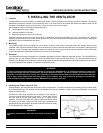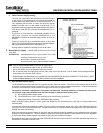
12 4034-102 Rev F 02/04
HRV200PLUS INSTALLATION INSTRUCTIONS
b. Install Fresh Air Supply Ducting
The inner and outer liners of the insulated duct must be clamped
to the sleeve of the weatherhood as close to the outside as
possible and to the plastic inlet port on the HRV200PLUS. It is
very important that the fresh air intake line be given special
attention to make sure it is well sealed. A good bead (½) of
high quality caulking (preferably acoustical sealant) will seal the
inner duct to both the HRV port and the weatherhood prior to
clamping.
To minimize air flow restriction, the flexible insulated duct (if
used) that connects the outside weatherhood to the
HRV200PLUS should be stretched tightly and be as short as
possible.
Twisting or folding the duct will severely restrict air flow. See
Figure 2 for the recommended connection of insulated ducts to
the outside weatherhood and the HRV200PLUS.
Ducting must be installed in accordance with local codes.
2. Warmside Air Supply - Heated fresh air from the HRV into the
living area
Duct Materials: Insulated Metal Air Duct - rigid or flexible, 200°F rated
CoolVent Flexible Pipe may be used.
Duct Adapter - (Simplified Installation)
Diffusers or Grilles - 200°F rated (Dedicated Installation)
Note: Due to elevated temperatures in the fresh air supply duct:
Use only ducting materials rated for use at or above 200°F
Do not use plastic duct or terminations rated below 200°F.
Do not connect fresh air supply duct into the return duct work of the furnace. Hot air stream could damage exposed
components in the furnace return cabinet.
WHEN USING THE EXISTING DUCT WORK FOR AIR DISTRIBUTION, ALWAYS CONNECT TO THE SUPPLY DUCT
WORK DOWNSTREAM OF THE CENTRAL FURNACE OR AIR HANDLER.
a. Duct the Warmside Air Supply
The HRV200PLUS recovers heat from the fireplace normally wasted in the flue. This means that the temperatures achieved
in the fresh air stream to the home will typically be 100°F hotter than the outdoor ambient temperature. Under some operating
conditions, the temperature inside the fresh air supply duct could be as high as 200°F.
The fresh air should be supplied to all living areas and bedrooms, excluding bathrooms, kitchens and utility areas.
The fresh air supply may be delivered to the home through a dedicated duct system when:
1) No central forced air system exists,
2) The HRV200PLUS is not in close proximity to the central supply air ducts or
3) Heating load design factors favor dedicated supply registers.
When dedicated supply grilles are used, grilles that diffuse the air comfortably from high wall or ceiling locations are
recommended.
In homes with a forced air distribution system, direct connection to the furnace supply duct work is the preferred method for
supplying fresh air from the HRV200PLUS. This will ensure fresh air is delivered evenly throughout the house and utilizes the
existing duct work infrastructure.
When connected to the furnace supply air duct work, the duct adapter should be installed to insure reliable air flow and stable
operation of the HRV200PLUS. The duct adapter is designed to minimize the effects of static pressure in the duct regardless
of the furnace blower speed selection and allows for fast, easy and airtight connections.
Remember to check the air flow balance of the HRV200PLUS with the furnace fan both on and off to determine that it does not
imbalance the ventilator more than 10%.
Figure 2


















